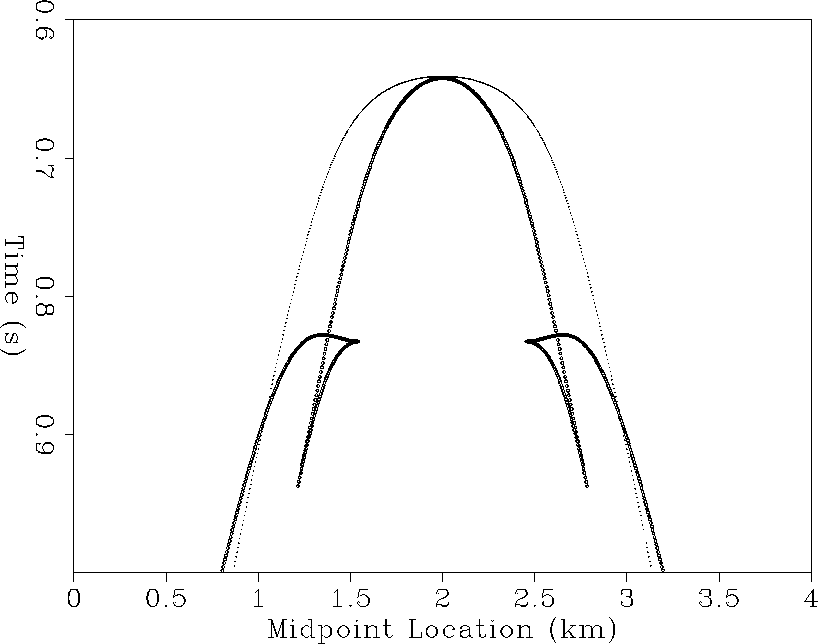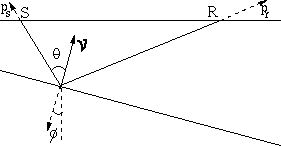|
shot1
Figure 1 Individual shot gather: the circular lens is a low velocity anomaly so the traveltimes and pr are identical. |  |
The kinematics of shot domain common image gathers and offset domain image gathers are well understood in constant velocity and v(z) media. Difficulties arise when we begin considering complex subsurfaces with rapid lateral velocity variations. Even in 2-D it is easy to construct a model for which an individual common shot gather or common offset gather can contain two events from two points in the subsurface that arrive at the same time and are indistinguishable. Let us investigate particular cases of these occurrences.
An individual common shot gather is parameterized by the receiver location r. If two raypaths between the same source and receiver exist such that they have the same receiver horizontal slowness pr and the two-way traveltime along each is the same, it is impossible to distinguish between the two reflector locations Nolan and Symes (1996). Figure 1 shows a very simple case of this.
|
shot1
Figure 1 Individual shot gather: the circular lens is a low velocity anomaly so the traveltimes and pr are identical. |  |
An individual common offset gather is parameterized by midpoint m. Suppose that the horizontal midpoint slowness pm = ps + pr is the same for two raypaths with the same traveltimes. Once again, the two raypaths represent the same event, and the location of the reflector causing this event is completely ambiguous. Figure 2 shows a case where ps1=-pr1 and ps2=-pr2 so that pm1=pm2=0.
|
offset1
Figure 2 Individual offset gather: the circular lens is a low velocity anomaly so the traveltimes are identical and the midpoint slownesses are equal. |  |
|
dualcurve1
Figure 3 Traveltime curves for the model in Figure 2. The thick curve is for the deeper diffractor, the thin curve is for the diffractor in the center of the anomaly. |  |
By shooting a fan of rays from both ![]() locations in
Figure 2, it is possible to obtain traveltime curves
for a common offset. These curves are shown in Figure 3.
The traveltime curve for the diffractor inside the anomaly is nicely
hyperbolic. The curve for the deeper diffractor has large symmetrical
triplications.
At this offset, the traveltimes for both curves are identical for the
midpoint directly above the diffractors. From the geometry of the model,
it is clear that the midpoint slownesses are the same, therefore the
events in the data will be indistinguishable.
locations in
Figure 2, it is possible to obtain traveltime curves
for a common offset. These curves are shown in Figure 3.
The traveltime curve for the diffractor inside the anomaly is nicely
hyperbolic. The curve for the deeper diffractor has large symmetrical
triplications.
At this offset, the traveltimes for both curves are identical for the
midpoint directly above the diffractors. From the geometry of the model,
it is clear that the midpoint slownesses are the same, therefore the
events in the data will be indistinguishable.
 |